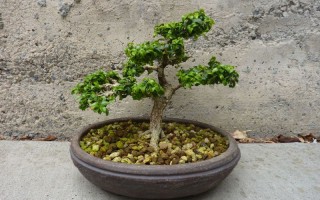The long history of the Kingsville boxwood starts in 1913 when it was found growing as a witches broom on a normal boxwood. The owner of the boxwood rooted 10 cuttings of this small growth and grew them for 10 years whereupon on his death, they fell into the hands of a nurseryman whose nursery was located near the town of Kingsville, Maryland, hence the name. The little boxwood was not the commercial success that the nurseryman had hoped until they were discovered in the 1960’s by the bonsai world. In 1975, one of the original 10 cuttings was still alive and was donated to the National Arboretum. It had been grown as nursery stock and it took several years of training before the tree became a fine bonsai.
Kingsville boxwoods are readily available and are trees that should be in every bonsai collection. The little trees grow very slowly only adding one half to three quarters of an inch each year. Due to this very slow growth Kingsvilles are usually seen as shohin or as part of a group planting. On the rare occasions when a larger Kingsville is shown it should be appreciated as being a very old tree.
Cultural requirements of Kingsvilles are modest. Their natural growth is usually wider than high although they can be slowly trained as an upright tree. The trees seem to prefer somewhat deeper pots due to the fact that although the above ground growth is slow the growth of the root ball is faster than you might expect for such a little tree. Kingsvilles along with regular boxwoods do best in open, shaded areas since exposure to strong sunlight leads to yellowing of the leaves. Kingsvilles particularly resent drying out and show their disgust by promptly dying. As the branches age, they become brittle so great care is needed when working with them.
Just as rarely a bud on a normal tree gets its genetics and/or chemistry wrong, buds on witches brooms once in a great while get their act right and produce a normal sized branch. When this happens, the normal branch grows so much faster than the rest of the tree that it takes charge and the smaller branches quickly die. Fortunately, Kingsvilles seem to do this less often than most of the cultivated witches brooms. In case this does happen, the normal branch should be removed as soon as it is identified. Incidentally, as an aside, many variegated plants occasionally produce a “normal” totally green branch and these, too, should be removed before they take over the whole plant.
A question that frequently comes up is whether bonsai can be grown inside the house. Bonsai can and should be taken inside for a few days to fully enjoy them but should then quickly be taken back outside. Extended periods inside usually lead to a precipitous decline in the health of bonsai trees due to poor light and dry atmosphere and should be avoided with a couple of exceptions. Kingsville boxwoods, as well as some tropical Ficus species, can be grown inside by very careful maintaining water and light.
Kingsvilles have many endearing attributes as bonsai. If you haven’t tried your hand at growing them, watch for them on local sales tables.

